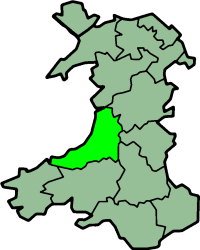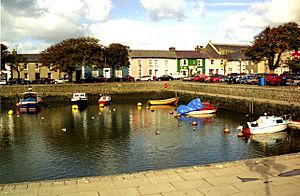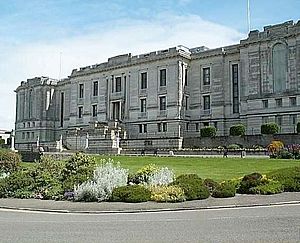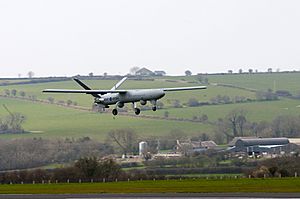Ceredigion facts for kids
Quick facts for kids
Ceredigion
|
|||
|---|---|---|---|
| Sir Ceredigion (Welsh) | |||
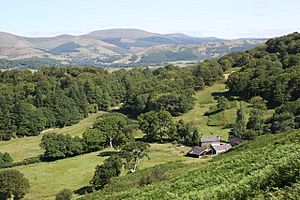 |
|||
|
|||
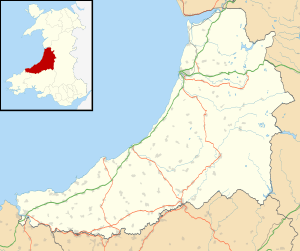 |
|||
| Sovereign state | |||
| Country | |||
| Preserved county | Dyfed | ||
| Established | 1 April 1996 | ||
| Admin HQ | Aberaeron and Aberystwyth | ||
| Largest town | Aberystwyth | ||
| Government | |||
| • Type | Ceredigion County Council | ||
| Area | |||
| • Total | 1,783 km2 (688 sq mi) | ||
| Area rank | Ranked 4th | ||
| Population
(2015)
|
|||
| • Total | 74,600 | ||
| • Rank | Ranked 19th | ||
| • Density | 41/km2 (110/sq mi) | ||
| • Density rank | Ranked 21st | ||
| • Ethnicity | 99.5% White | ||
| Welsh language | |||
| • Rank | Ranked 4th | ||
| • Any skills | 61.2% | ||
| Geocode | 00NQ (ONS) W06000008 (GSS) |
||
| ISO 3166 code | GB-CGN | ||
Ceredigion ( kerr-Ə-dig-EE-ən --EE-on) is a county in the west of Wales, corresponding to the historic county of Cardiganshire. During the second half of the first millennium Ceredigion was a minor kingdom. It has been administered as a county since 1282. Ceredigion is considered a centre of Welsh culture and more than half the population can speak Welsh. The county is mainly rural with over 50 miles (80 km) of coastline and a mountainous hinterland. The numerous sandy beaches and the long-distance Ceredigion Coast Path provide excellent views of Cardigan Bay.
In the 18th and early 19th centuries, Cardiganshire had more industry than it does today; Cardigan was the commercial centre of the county; lead, silver and zinc were mined and Cardigan was the principal port of South Wales prior to the silting of its harbour. The economy became highly dependent on dairy farming and the rearing of livestock for the English market. During the 20th century, livestock farming became less profitable, and the county's population declined as people moved to the more prosperous parts of Wales or emigrated. However, there has been a population increase caused by elderly people moving to the county for retirement, and various government initiatives have encouraged tourism and other alternative sources of income.
Ceredigion's population at the 2011 UK census was 75,900. Its largest town, Aberystwyth, is one of its two administrative centres, the other being Aberaeron, where Ceredigion County Council meets. Aberystwyth houses Aberystwyth University, Bronglais Hospital and the National Library of Wales. Lampeter is home to part of the University of Wales Trinity Saint David. The area is administered by Ceredigion County Council.
History
Ceredigion has been inhabited since prehistoric times: 170 hill forts and enclosures have been identified across the county and there are many standing stones dating back to the Bronze Age. Around the time of the Roman invasion of Britain, the area was between the realms of the Demetae and Ordovices. The Sarn Helen road ran through the territory, with forts at Bremia and Loventium protecting gold mines near present-day Llelio. Following the Roman withdrawal, Irish raids and invasions were repulsed, supposedly by the forces under a northerner named Cunedda. The 9th-century History of the Britons attributed to Nennius records that Cunedda's son Ceredig settled the area around the Teifi in the 5th century. The territory supposedly remained a minor kingdom under his dynasty until its extinction upon the drowning of Gwgon ap Meurig c. 871, after which it was administered by Rhodri Mawr of Gwynedd before passing to his son Cadell, whose son Hywel Dda inherited its neighbouring kingdom Dyfed and established the realm of Deheubarth. The era—whose Viking invasions destroyed many monastic records—is highly obscure; some historians believe the Dyfed ruler Hyfaidd ap Bledrig may have annexed Ceredigion before his heirs lost it to Hywel through war.
Many pilgrims passed through Cardiganshire on their way to St Davids. Some came by sea and made use of the churches at Mwnt and Penbryn, while others came by land seeking hospitality at such places as Strata Florida Abbey. Both the abbey and Llanbadarn Fawr were important monastic sites of scholarship and education. Place names including ysbyty denote their association with pilgrims.
In 1282, Edward I of England conquered the principality of Wales and divided the area into counties. One of thirteen traditional counties in Wales, Cardiganshire was also a vice-county. Cardiganshire was split into the five hundreds of Genau'r-Glyn, Ilar, Moyddyn, Penarth and Troedyraur. In the 18th century there was an evangelical revival of Christianity, and non-conformism became established in the county as charismatic preachers like Daniel Rowland of Llangeitho attracted large congregations. Every community built its own chapel or meeting house, and Cardiganshire became one of the centres of Methodism in Wales with the Aeron Valley being at the centre of the revival.
Cardigan was one of the major ports of southern Wales, but its harbour silted in the mid-19th century and the Industrial Revolution largely passed the area by. In the uplands, wheeled vehicles were rare in the 18th century, and horses and sleds were still being used for transport. On the coast, trade in herrings and corn took place across the Irish Sea. In the 19th century, many of the rural poor emigrated to the New World from Cardigan, between five and six thousand leaving the town between 1790 and 1860. Aberystwyth became the main centre for the export of lead and Aberaeron and Newquay did brisk coastal trade. The building of the railway from Shrewsbury in the 1860s encouraged visitors and hotels sprang up in the town to accommodate them.
This area of the county of Dyfed became a district of Wales under the name Ceredigion in 1974 under the Local Government Act 1972, and since 1996, has formed the county of Ceredigion. According to the 2001 census, Ceredigion has the fourth highest proportion of Welsh speakers in the population at 61%; only Gwynedd, the Isle of Anglesey and Carmarthenshire have a higher proportion.
Geography
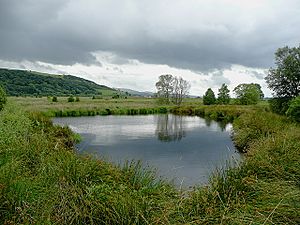
Ceredigion is a coastal county, bordered by Cardigan Bay to the west, Gwynedd to the north, Powys to the east, Carmarthenshire to the south and Pembrokeshire to the south-west. Its area is 1,795 square kilometres (693 sq mi). In 2010 the population was 76,938, making it the second most sparsely populated county in Wales.
The main settlements are Aberaeron, Aberporth, Aberystwyth, Borth, Cardigan, Lampeter, Llanarth, Llanddewi Brefi, Llandysul, Llanilar, Llanrhystud, Llanon, New Quay, and Tregaron. The largest of these are Aberystwyth and Cardigan.
The Cambrian Mountains cover much of the east of the county; this large area forms part of the desert of Wales. In the south and west, the surface is less elevated. The highest point is Pumlumon at 2,467 feet (752 m), other Marilyns include Pen y Garn and Llan Ddu Fawr. On the slopes of Pumlumon five rivers have their sources: the Severn, the Wye, the Dulas, the Llyfnant and the Rheidol, the last of which meets the Afon Mynach in a 300 feet (91 m) plunge at the Devil's Bridge chasm. The largest river is the River Teifi which forms the border with Carmarthenshire and Pembrokeshire for part of its length. The towns of Lampeter, Llandysul, Newcastle Emlyn and Cardigan are all in the Teifi Valley, and each has communities on each side of the river, in different counties. Other significant rivers include the River Aeron which has its estuary at Aberaeron, and the River Ystwyth and the River Rheidol both of which reach the sea in Aberystwyth harbour.
Ceredigion's 50 miles (80 km) of coastline has sandy beaches. In 2011 Ceredigion's beaches were awarded five Blue Flag Awards, four Green Coast Awards, and fourteen Seaside Awards. Ceredigion is one of only two places in the United Kingdom with a permanent presence of bottlenose dolphins. Another member of the fauna is the red kite; these may be seen in various localities in the county, but at the Red Kite Feeding Centre near Tregaron, they are fed each day, and large numbers congregate along with hungry crows and other birds.
Ceredigion had the largest population growth of any county in Wales, with a 19.5% increase from 1991 to 2003. Tourism and agriculture, chiefly hill farming, are the most important industries. In addition, two universities are within the county boundaries: Aberystwyth University and the Lampeter campus of the University of Wales, Trinity Saint David. The Welsh Plant Breeding Station is near Aberystwyth and linked to the University. The National Library of Wales, founded in 1907, is also in Aberystwyth. Ceredigion is an extremely rural county; the largest town, Aberystwyth, has fewer than 15,000 permanent residents and the remainder of the population of the county is scattered over 150 small towns, villages and hamlets.
The county has no large commercial areas. The nearest substantial settlements are located at least 1 hour 45 minutes drive away. Approximate road distances from Ceredigion's largest town, Aberystwyth, are: Swansea, 75 miles (121 km) to the south; Shrewsbury, 76 miles (122 km) to the east, in the English county of Shropshire; and Wrexham, 82 miles (132 km) to the northeast. The capital, Cardiff, is over 100 miles (160 km) from most parts of the county. Although Ceredigion and Gwynedd share a boundary, it is not possible to travel directly between the two by land as all road and rail links avoid the Dyfi estuary and pass through Dyfi Junction or Machynlleth in Powys.
Dylan Thomas lived in New Quay and Talsarn and frequented Aberaeron and Lampeter. The Dylan Thomas Trail runs through part of the county, linking the places associated with the poet. The Ceredigion Coast Path is a long-distance footpath following the coastline from Cardigan to Ynyslas, a distance of about 60 miles (97 km). It can conveniently be divided into seven sections and has some spectacular scenery.
Sport and leisure
The main football team in the county is Aberystwyth Town F.C. which plays in the Welsh Premier League, its home matches being at the Park Avenue ground in the town. It has yet to come higher than third in the League but won the Welsh Cup in 1899/1900 and the Welsh Amateur Cup in 1930/31, 1932/33 and 1969/70. Cardigan Town Football Club, also known as the "Magpies", play in Division 1 of the Ceredigion League which they won in 1968/69, 1995/96, 1999/2000, 2000/01 and 2002/03.
Leisure activities available in the county include beach activities, rambling, cycling, sea fishing, canoeing, sailing and horse riding. Many of the towns and villages along the coast have small harbours and facilities for sailing, dolphin watching and other maritime activities. The River Teifi is a renowned salmon fishing river and also has a series of rapids near Llandysul where canoeing, kayaking and white water rafting take place.
The county is rich in archaeological remains such as forts, earthworks and standing stones. Historic sites that can be accessed include Aberystwyth Castle and Cardigan Castle, as well as Strata Florida Abbey.
Other visitor attractions include the Cwmystwyth Mines, Devil's Bridge, the Bwlch Nant yr Arian Forest Visitor Centre, Elvis Rock, Cors Caron (Tregaron bog), the Vale of Rheidol Railway, Aberystwyth Cliff Railway.
The National Library of Wales is at Aberystwyth and there is information on local history at the Ceredigion Museum, also in Aberystwyth. There is also the technical museum Internal Fire – Museum of Power, which is at Tan-y-groes near the coast road. Stately homes in the county open to the public include the Hafod Estate and Llanerchaeron.
Transport
The Cambrian Line provides mainline railway services between Aberystwyth, Shrewsbury and Birmingham where passengers can join services for London and elsewhere. Passengers can change at Dovey Junction railway station for trains along the Cambrian Coast Line to Pwllheli. There are no motorways in Ceredigion, the nearest is the western end of the M4 motorway at Pont Abraham near Pontarddulais in Carmarthenshire. The Fishguard to Bangor trunk road, the A487, travels in a northeast direction following the coast from Cardigan to New Quay, through Aberaeron and Aberystwyth. The A44 travels eastwards from Aberystwyth to Llangurig before turning south then east through Rhayader, Leominster and Worcester.
There are local bus services between the main centres of population, and long distance services between Aberystwyth and Cardiff via Aberaeron and Lampeter. A bus service known as "Bwcabus" operates in the south of the county offering customised transport for rural dwellers. TrawsCymru T1 service runs between Aberystwyth and Carmarthen with runs through Aberaeron and Lampeter.
Aberporth Airport, southeast of Aberporth, is being developed as West Wales Airport for domestic flights within Wales and the rest of the United Kingdom. The airport is also developing as a centre for the deployment of civil and military unmanned aerial vehicles (UAVs), also known as 'drones'. The airport underwent major improvements in 2008 which extended the length of the runway from 945 to 1,257 m (3,100 to 4,124 ft).
Economy
Farming has traditionally been the basis of Cardiganshire's economy, with dairying and stock-rearing being the main occupations. Before the first railway was built in 1866, the stock used to be herded over the mountains to England, where Rugby, Northampton and London were important destinations. At one time there was a sizeable mining industry in Cardiganshire, but the reserves of lead, silver and zinc became unprofitable to mine by the early 20th century. Shipping was also important in the county, with coal and lime being imported in coastal vessels, and mineral ores and oak bark for tanning being exported. Shipbuilding was an important industry: most of Wales' sailing vessels were built in Cardiganshire.
Cardiganshire had a substantial population in the early modern period, but this declined during the 19th century as wider social and economic developments affected all aspects of Cardiganshire life. Traditional industries were in decline, agriculture was in decline and it was becoming increasingly difficult for a still-rising population to earn a living within their native parishes and communities. By the first half of the 20th century, falling livestock prices and greater international competition made farming unprofitable. Many residents of Cardiganshire moved to other parts of South Wales, where there were better employment opportunities, and many more emigrated to the United States, Canada, Patagonia and Australia. Furthermore, the owners of the great landed estates, who had for so long dominated the politics of the county, were in many cases heavily in debt. This led to the loss of landowner influence in the running of the county; this became very apparent at the first elections to the Cardiganshire County Council in 1889.
By the second half of the 20th century, the population was increasing again. More retired people were arriving to make their home in the tranquil surroundings, and after the Beacham Commission in the 1960s, the British government realised that the rural way of life in parts of Wales was in crisis, and started to react. Through government initiatives and local actions, opportunities in tourism, rural crafts, specialist food shops, farmers' markets and added-value food products began to emerge. However, in 2011, at 3.1%, Ceredigion still had one of the highest proportions of its population working in agriculture, forestry and fishing, close behind such other places as Orkney and Shetland. Exposed, marginal land is also used for wind farms: Cefn Croes Wind Farm near Devil's Bridge has 39 turbines and a nominal capacity of 58.5 MW.
Farm incomes have been in decline over the years; and, as well as being a European Objective I area, in 2001 Ceredigion was designated a regional "Tourist growth area" by the Wales Tourist Board. There is little industry other than farming, so tourism plays an important part in the county's economy. Visitors stay in hotels, guest houses and homes offering bed-and-breakfast, self-catering cottages, caravans and camp sites; they spend money in local shops, dine in local establishments and visit the county's many attractions. Ceredigion prides itself on offering an unspoilt natural landscape, and Aberystwyth claims to be the capital of Welsh culture.
Images for kids
-
Cors Caron, near Tregaron
See also
 In Spanish: Ceredigion para niños
In Spanish: Ceredigion para niños




